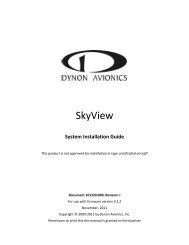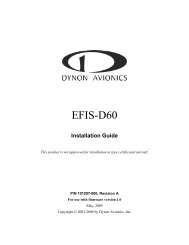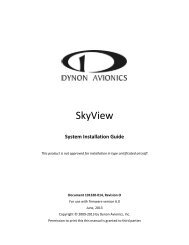EFIS-D100 Installation Guide - Dynon Avionics
EFIS-D100 Installation Guide - Dynon Avionics
EFIS-D100 Installation Guide - Dynon Avionics
Create successful ePaper yourself
Turn your PDF publications into a flip-book with our unique Google optimized e-Paper software.
Autopilot <strong>Installation</strong> and Configuration<br />
Note: As with the optional <strong>Dynon</strong> HS34, it is acceptable to connect the tone output of <strong>EFIS</strong><br />
(DB25 Pin 18) and/or EMS (DB37 Pin 31) in parallel with the tone/voice output of the AP74<br />
(Pin 25) to provide “failover” audio alerts from the <strong>EFIS</strong> and/or EMS if the AP74 were to fail.<br />
However, do not connect the audio outputs from an HS34 and AP74 in parallel.<br />
Servo Mechanical <strong>Installation</strong><br />
<strong>Dynon</strong> <strong>Avionics</strong> has researched suitable mounting points for a number of popular aircraft and<br />
offers mounting kits and instructions for them. If you have purchased one of these kits, use the<br />
instructions included with it as your primary guide; the following mechanical installation<br />
information is more general in nature.<br />
For installing <strong>Dynon</strong> <strong>Avionics</strong> servos in aircraft for which <strong>Dynon</strong> does not offer kits, we offer a<br />
“generic” kit of basic parts and basic installation instructions: <strong>Dynon</strong> P/N 101020-000. The<br />
generic servo push-pull mounting kit includes some of the hardware to mount a servo and<br />
connect to the aircraft controls, but requires the installer to fabricate mounting brackets. This kit<br />
can be used in either pitch or roll applications that use a servo with an output arm (not suitable<br />
for use with pulley/cable servos). Some additional fasteners (not supplied by <strong>Dynon</strong>) and<br />
brackets will be required depending on the installation method chosen.<br />
CAUTION: Neglecting to properly install and/or use <strong>Dynon</strong> <strong>Avionics</strong> AP hardware can<br />
result in failures which could cause loss of aircraft control resulting in aircraft damage,<br />
personal injury, or death. If there are any questions on the part of the installer it is<br />
mandatory to resolve these questions prior to flight.<br />
When installing the servo, you must first determine a mount location for proper interaction with<br />
the existing control system. The mounting point that is chosen must allow the servo arm and<br />
associated linkage to move freely through the entire range of travel. To prevent the possibility of<br />
the servo arm going OVER CENTER, the servo arm must not travel more than a total of +/-60º<br />
from neutral position. When the aircraft controls are centered, the arm of the servo should be<br />
perpendicular to the attaching push rod. If this is not the case, we recommend adjusting the<br />
length of the push rod or consider a different mounting point. For maximum efficiency and the<br />
lightest drag on the flight controls, you should choose the smallest servo that provides sufficient<br />
torque to move and hold the flight controls with a minimum of “slippage”. A diagram of servo<br />
torque versus mount position is shown on page 6-9.<br />
CAUTION: The servo arm must not rotate even near to the point called OVER<br />
CENTER, the point at which the primary aircraft control would “lock up”. Over center<br />
happens when the angle between the servo arm and the attached push rod becomes so<br />
great that the control system cannot drive against the servo arm. To protect against this<br />
possibility, a Range of Motion Limiting Bracket is supplied with each <strong>Dynon</strong> <strong>Avionics</strong><br />
servo. These brackets are drilled so that they can be mounted at different angles as<br />
required (18° intervals). The brackets are supplied for the protection of the pilot, and we<br />
recommend that the Range of Motion Limiting Bracket be installed to ensure that an<br />
OVER CENTER condition cannot occur.<br />
Once a suitable mounting point for each servo has been determined, the next step is to fabricate a<br />
mount for the servo to attach to the aircraft. Generally this will be a bracket made of sheet metal<br />
or corner stock. <strong>Dynon</strong> recommends using 6061 T6 aluminum with a minimum thickness of<br />
6-6 <strong>EFIS</strong>-<strong>D100</strong> <strong>Installation</strong> <strong>Guide</strong>
















